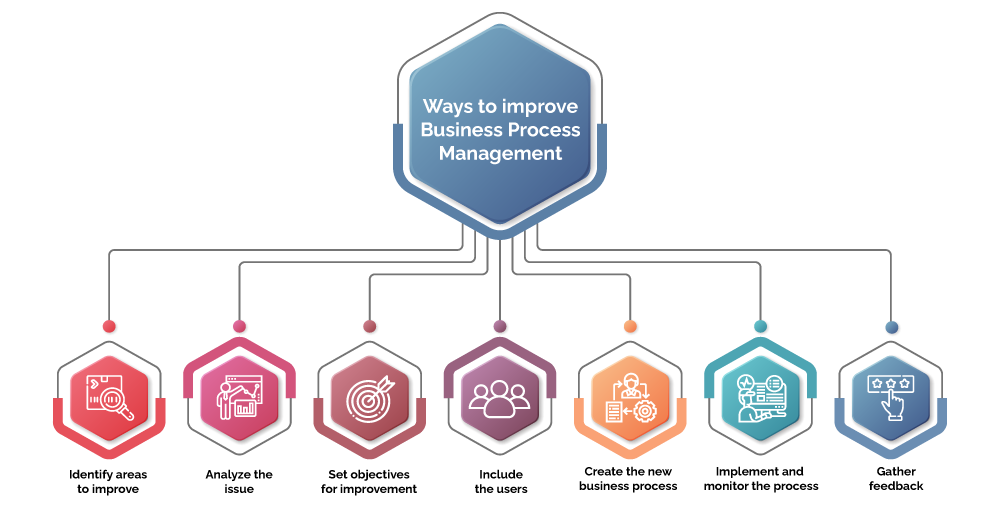
This article was first published on Thrive Global.
As Steve Jobs said, “If you define the problem correctly, you almost have the solution.” This holds, especially for an activity like business process management. This activity depends almost entirely on understanding the problem that needs to be solved and then providing a process that might clarify the confusion.
If you define the problem correctly, you almost have the solution.
Steve jobs
Business process management has turned into a staple for every company if they want to increase productivity and efficiency. However, due to the recent pandemic, companies have been forced to adopt new ways of working. Here are a few tips on how to set up good business processes or improve existing processes while working from home:
What is Business Process Management?
Business process management is the process of defining a series of activities or steps that can help you achieve a defined business goal. This is a continuous task and involves constantly looking for ways to improve your current business processes.
This also involves recording and keeping track of the processes that are currently in place. Documentation and recording of processes are very important as it gives the company a reference for what works and what doesn’t. The processes in place need to be examined closely to ensure that they’re time- and cost-efficient.
These business processes may be formal or informal processes. Formal processes will be strict and properly defined to ensure that there’s no confusion while going through the process. These processes are generally in critical departments, such as departments related to legal, financial, or safety issues.
Also read: Business Process Management – The What, Why, and How
Informal processes are general, casual processes that have been set up to provide direction for other tasks. These tasks could involve setting up meetings in your department or how to use internal communication streams. These processes may not be documented as they might not be widely used throughout the business, or they’ve been created for very simple tasks.
Business process management is the process of defining a series of activities or steps that can help you achieve a defined business goal.
Benefits of Business Process Management
There are several benefits to setting up efficient business processes through business process management:
1. Greater Efficiency
When employees have a clearly defined process and goal to follow, it can prevent a task from becoming inefficient due to a lack of measurable progress or misplaced effort. A well-designed business process can eliminate unnecessary activities and tasks.
2. Better Flexibility
Flexibility is important for a business to stay relevant in the industry. As your business involves partners, competitors, and vendors, your processes must be flexible. New opportunities or regulations may require you to be flexible regarding how you develop business processes through business process management.
3. Greater Accountability
If business processes are well-planned, employees have a clearer roadmap to follow as they try to achieve goals. This clear business process also provides a way to hold individuals accountable when it comes to deliverables.
4. Greater Effectiveness
Better planning of business processes can lead to better decisions, better execution of tasks, and better service provided to the customer. This shows that business process management can greatly increase the effectiveness of the employee’s efforts.
Also read: BPM Software – 10 things to consider to choose the right one
Ways to Improve Business Process Management
Here are a few ways to improve business process management in your business:

1. Identify areas to improve
You need a clear idea of which areas need improvement and which are functioning well. Through this step, you can understand what is working and implement key learnings in areas that aren’t working smoothly. It is also important to understand which employees or end-users are involved in certain areas and business processes. You can get a clear idea of where you’re starting from as well as where you’re hoping to succeed through business process improvement.
2. Analyze the issue
Once you have identified the issues, examine and analyze them thoroughly to get a grasp of the obstacles that are causing problems. Make sure to include all of the sub-steps you might encounter while studying these processes.
3. Set objectives for improvement
After a thorough analysis, you can set clear objectives for business process improvement while considering the steps that need improvement or removal. Every step needs to be examined along with the employees or end users that are part of the step.
4. Include the users
The users may have important insights that can help you improve your processes depending on their view of what is going wrong. If they are involved from the beginning, they will see that their inputs are being acknowledged, leading to more openness towards any changes in the process in the future.
5. Create a new business process
Using the findings from the previous step, create a new process considering all of the feedback. This new process could involve using a new tool or creating a new business workflow that may work better than the previous one. Looking towards automation as a solution for streamlining the business process is a good idea. Considering 60% of all occupations have at least 30% of all activities that can be automated, automation is a good choice while setting up an improved business process.
6. Implement and monitor the process
There may be resistance to change or unforeseen problems when improving on a pre-existing process. Monitor the new process for a few weeks/months until you’re sure that all of the problems have been tackled and the process is running smoothly.
7. Gather feedback
Once the new business process is actively running, gather user feedback regarding how the process works. This can help you stay aware of problems that may crop up in the future and continue making small improvements to keep the process relevant and effective. Constant improvements are important for effective business process management.
Examples of improved Business Process Management
Improving the business processes through business process management can help with the following:
- increasing efficiency
- removing bottlenecks in existing processes
- increasing productivity
- maintaining good quality in the service or product
- producing better performance from employees
- improving customer service
- ensuring backup processes are available
- decreasing the risks and chances of failure
Quixy helped a leading IT company, Navayuga Infotech, gain 20% more staff productivity and a 40% improvement in employee satisfaction. This was done by automating the existing business processes under one platform and allowing the employee to save time from doing mundane manual tasks. This form of improvement through BPM required a new platform that was created using the unique specifications necessary for individual processes in individual departments. Read more about this success story here!

Changes in Business Process Management due to work from home
Due to the pandemic of Covid-19 that has swept across the world, the business landscape has changed, especially when it comes to working from home. Due to the lockdowns that were implemented worldwide, businesses and companies decided to give employees the chance to work from home.
Working from home involves employees working in the same space that they live in.
Business processes have also been called into question during this tumultuous period. Business process management has become more important than ever, as new processes need to be put into place to ensure an efficient workflow.
How to improve business processes while working from home
There are definitely businesses that are thriving in this new business landscape. To help your company make the most of this unprecedented situation, here are a few ways to improve business process management:
Define a method of connectivity and communication
In these confusing times, remote work can become an inescapable tangle of messages, emails, and other overlapping communication. This problem can lead to confusion regarding what work is completed as well as where it has been sent, which can cause miscommunication when it comes to following existing business processes.
It might become necessary for companies to rethink their current communication streams and ensure there are better systems in place through business process management. Communication can be done through live-chat systems like Slack or implementing document-sharing tools to allow employees to work on one document simultaneously.
Accept the rising culture of meetings
Currently, every employee who’s working from home will be able to acknowledge the unmistakable rise of constant meetings and calls. This has become a big change as employees are unable to have organic conversations as they used to in the workplace. The frequency of meetings is a big behavioral change, and this frequency doesn’t seem to be decreasing anytime soon.
Your business needs to consider this trend and invest in tools that can help employees set up meetings easily. Your existing business processes may be irrelevant in the current situation, and as part of BPM, it’s necessary for you to keep an eye out for more efficient tools.
Currently, tools like Zoom and Google Meets are the most popular, along with Microsoft Teams for those who use Microsoft tools frequently. Wired conducted a review comparing the 6 top video-conferencing tools in the market. These tools can help your meetings happen seamlessly, and setting up new business processes using these tools is a good idea that can benefit remote workers.
Allow for focused time
As mentioned above, meetings are definitely on the rise. However, while scheduling meetings, most employees are simply trying to find a suitable time for everyone who needs to be on the call. This can cause a build-up of meetings which have a maximum of 10-15 minutes in between for the individual to take a small break. This can result in small amounts of time wasted due to the meetings that are bookending this free time on either side.
Pockets of 10-20 minutes can be great as a short break if there’s a plan in place for completing tasks. However, employees may feel overwhelmed in these situations. Time-tracking applications can help employees manage their time and help managers track how much time is spent on certain tasks. This information can later help set up better and improved business processes.
It’s important for a business to encourage employees to manage their time smartly and allow for enough free time to get bigger, more important tasks done. This can be done using project management tracking apps, which can help managers and employees block out time that is necessary to complete bigger tasks in a project. Popular applications like Asana, Trello, and Airtable could be a good choice for tracking task completion within a team in your business. If these applications don’t suit your needs, you can even try building a custom project management system through no-code using a service like Quixy.
Automate menial tasks
Automation is a technology that can provide benefits like improved quality of work, lower costs, and standardized procedures for particular activities. Automation can help remove the burden off employees’ shoulders when it comes to menial, manual tasks. To allow employees to focus on other, more important tasks, automation tools can be great for setting up new business processes suited to your needs. Manual tasks like sending emails, filling out forms, or sending reminders to other employees can be automated to allow employees to regain lost time.
Implementing automation tools can help remind employees of incomplete work, recommend escalation if work has not been completed for a long time, and allow employees to get an accurate idea of the tasks they need to complete.
Review performance and embrace feedback
Employees need to have clear ways to provide feedback, and companies need to be open to accepting and implementing this feedback. Employee feedback at this time is invaluable as it can clearly define the obstacles that are preventing them from working at full capacity. This can lead to rethinking existing business processes and creating newer, more efficient processes to suit current needs.
Companies need to have an easy method of reviewing the performance of the employees against the established KPIs (Key Performance Indicators). Companies also need good data and reporting systems to ensure that employees can access this data freely and easily. This can help encourage better team performance and ensure that no critical failures or faults are overlooked. Efficient business processes for managing data during these times are invaluable for every company.
Set clear business objectives
While remote work can lead to better-enhanced productivity due to the ease of working from home, it can also lead to confusion and miscommunication among employees. The business needs to have a clear goal and defined objectives in place to ensure that the employees have a clear roadmap to follow. The objectives that are set should correlate with the overarching business objectives, and the employees need to have a clear vision of the future. This can help motivate employees and allow for better monitoring of employees against certain standards.
Schedule check-ins
Remote work may cause employees to feel alone and isolated from the rest of their peers. This can be remedied by ensuring that there are scheduled check-ins with the whole team on a common meeting. This can allow the employees to feel like they’re part of a team and help motivate them to work more efficiently and collaborate properly with the rest of the team.
These check-ins can help managers and employees stay in touch and prevent a disconnect which could lead to miscommunication and low morale further down the road. As these are unprecedented times, every company or business should look towards setting up new business processes for the sake of employees.
Avoid micro-management
Managers may be tempted to check in frequently with employees as they are no longer in a shared workplace. This could lead to irritation and confusion among the employees and cause discontent. Practices like a weekly check-in meeting should be enough to keep the employees on track to finishing their work. As mentioned above, project management tools may be a good idea to help managers keep track of the progress of a task toward a goal. New business processes regarding project management could help overcome this obstacle and accelerate growth.
Implementing Business Process Management during WFH
Business process management can help businesses take control of this situation and come out better and more efficient. Business processes are the backbone of all of the tasks undertaken in a business, and it’s important to make them as efficient as possible. Whether it involves adopting new tools, improving pre-existing processes, or removing unnecessary steps, business process management can prove invaluable in the long run.
Quixy is a no-code platform that has the capability to create apps that are suited to your exact needs. With a clear visual interface and an easy drag and drop builder, Quixy can help with all your business process management needs. Begin your journey towards streamlined operations and tailored apps – all with the simplicity of our platform. Get started today to harness the potential of automation.
Login
Please login to comment
0 Comments
Oldest
















